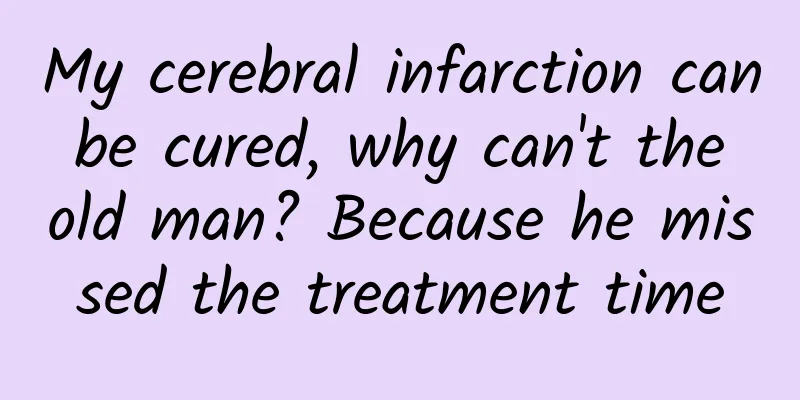My cerebral infarction can be cured, why can't the old man? Because he missed the treatment time

|
In the hospital, an aunt was crying and begging the doctor because her husband had a cerebral infarction. She asked the doctor to give her husband thrombolytic therapy, but the doctor disagreed. The aunt said that she had also suffered a cerebral infarction a few years ago, and she was given a "thrombolytic" treatment at the hospital. Why did the hospital refuse to treat her husband when he had the same disease? The doctor explained that it was not that she did not want to be treated, but because her husband had been ill for more than a day, which had exceeded the time window for thrombolytic treatment. At this time, thrombolysis and blood vessel clearance would not have any therapeutic effect, but might cause more serious damage. 1. Cerebral infarction delayed by "experience" The aunt said that she had suffered a cerebral infarction a few years ago. She was walking outside when she suddenly felt that her left leg had no strength and it felt like she was walking on cotton. However, she happened to be near a hospital at the time and struggled to walk into the hospital's clinic. The doctor diagnosed her with cerebral infarction and quickly performed thrombolytic therapy. After a short time, she fully recovered. Last night, her husband also had similar symptoms as her, saying that his legs and feet were weak. Based on her own experience as a "survivor", she judged that her husband might also have a blocked cerebral blood vessel. However, her husband did not have other more serious symptoms, so she was not anxious, thinking that she would be fine if she went to the hospital the next day to "open" the blood vessels. As a result, when she woke up in the morning, half of her husband's body was completely unable to move. She hurriedly called a taxi to take her husband to the hospital. The doctor told her that the thrombus could not be dissolved, so she became anxious. 2. Thrombolysis time after cerebral infarction is only 6 hours. The doctor told my aunt that her cerebral infarction could be treated with thrombolysis because she rushed to the hospital very promptly after the onset of the disease, and the thrombolysis effect was good and the risk was very small. However, her husband had been ill for more than 6 hours, so thrombolysis treatment could no longer be performed, otherwise it would easily cause cerebral hemorrhage and cause more serious damage. Brain nerve cells are highly differentiated cells. The life span of nerve cells is basically the same as that of the human body. Once they die, they cannot be regenerated. Moreover, brain nerve cells have very low tolerance to hypoxia and ischemia. When hypoxia exceeds 6 minutes, irreversible death will occur. When a cerebral infarction occurs, brain cells in the core area of the lesion begin to die first. Because of the small amount of blood supplied by the collateral circulation, brain cells outside the lesion will enter an ischemic dormant period and temporarily lose their function. If the blood vessels can be reopened in time and oxygen is supplied, these dormant brain cells can return to normal. Rescue after a cerebral infarction is to rescue these cells. However, if the blood supply cannot be restored for a long time, these dormant brain cells will also die. Therefore, after a cerebral infarction occurs, the faster the blood vessels are reopened, the more brain cells can be rescued. However, if it exceeds 6 hours, the vascular epithelial cells at the infarction site will also die and cannot maintain the normal vascular structure. If the blood vessels are reopened at this time, the blood pressure will break through the blood vessels, causing cerebral hemorrhage and causing more serious damage to the patient. 3. Seek medical treatment as soon as possible after a cerebral infarction occurs. Therefore, after a cerebral infarction occurs, what needs to be done is to identify it quickly and seek medical treatment quickly. Quick identification: sudden onset of sensory abnormalities such as dizziness, headache, blacking out, etc.; or sudden onset of abnormal consciousness such as forgetfulness, insomnia, aphasia, inability to understand words, etc.; or movement abnormalities such as running off track, easy falling, limited limb movement, inability to open eyes, drooling, and always choking when eating. When the above abnormalities occur, three simple actions can be used to distinguish: ask the patient to smile and see if the corner of the mouth is tilted to one side; raise both arms to see if one side of the arm is weak; speak a sentence to see if the speech is unclear. As long as one of the above abnormalities occurs, it is very likely that a cerebral infarction has occurred, and the onset time needs to be recorded and medical treatment should be sought quickly. Seek medical treatment quickly: Dial "120" and wait for rescue is the best option. If you are in a remote area or a place where it is inconvenient for "120" rescue, you can carry the patient to the doctor by yourself under the guidance of the "120" emergency center. When carrying the patient, try to keep him in a supine position. Patients with cerebral infarction may vomit, so the patient's head should be tilted to one side to avoid accidental inhalation of vomitus. When seeking medical treatment, choose the nearest hospital that can perform thrombolytic therapy, and do not go far to find a large hospital. Because after a cerebral infarction occurs, a large number of brain cells die every second, so rescue needs to race against time. If thrombolysis can be performed within 3 hours, there is a 70% probability that no serious sequelae will occur. If thrombolysis is performed within 6 hours, this probability will drop to 30%. If it exceeds 6 hours, only conservative treatment can be used, and thrombolysis cannot be performed. In summary, the rescue of cerebral infarction requires every second, and thrombolytic therapy has a time requirement, which is calculated from the onset of the disease and cannot exceed 6 hours. Patients with long-term "three highs" and atrial fibrillation are at risk of cerebral infarction and should be more vigilant. They should remember the symptoms of cerebral infarction, identify them quickly, and seek medical treatment quickly. I am pharmacist Huazi, welcome to follow me and share more health knowledge. |
>>: How to ride a bike that's good for your knees? What to bring for long-distance riding
Recommend
Bleeding at 7 weeks of pregnancy
Bleeding during the 7th week of pregnancy is an u...
I got pregnant on the fifth day after having sex.
Many female friends got pregnant again after havi...
The HPV vaccine is effective only after one shot, so are all three shots in vain?
It is hard to get a shot, and the topic is consta...
Causes of ovulatory bleeding after abortion
Many women experience ovulation bleeding after ch...
A woman lost her sight after falling, and experts from Zhejiang and Hubei provinces helped her regain her sight through "decompression" surgery
The bone around the optic nerve is carefully remo...
How many days after menstruation does a woman ovulate?
The egg is the largest cell in the female body an...
Is medical abortion harmful to women?
The answer is without a doubt, medical abortion c...
What to eat to cure ovarian aging quickly
Ovarian aging is a condition that is more common ...
Are breast enhancement pills useful? What to eat?
Some women often feel inferior because of their f...
Can eating kiwi fruit after barbecue help detoxify? What should not be eaten with barbecue?
Barbecue is also a technical job. First, wash the...
Can you tell the gender of your baby at two and a half months of pregnancy?
After 2 months of pregnancy, the baby in the bell...
Symptoms of spleen and stomach deficiency and dampness in women
In daily life, many people suffer from some abnor...
Bleeding after taking birth control pills for a few days
In life, some female friends will experience blee...
What causes insomnia during pregnancy?
Insomnia during pregnancy may be a problem encoun...









